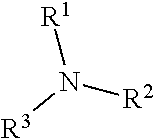Quaternary ammonium detergent fuel additives
a technology of detergent fuel additives and ammonium detergents, applied in the direction of fuel additives, liquid carbonaceous fuels, petroleum industry, etc., can solve the problems of poor fuel economy, dramatic difference between indirect direct fuel injected diesel engines, etc., to improve the performance of the fuel injector and improve the performance of the direct fuel injected diesel engin
- Summary
- Abstract
- Description
- Claims
- Application Information
AI Technical Summary
Benefits of technology
Problems solved by technology
Method used
Image
Examples
##ventive example 1
Inventive Example 1
[0066]Polyisobutenyl succinic anhydride (PIBSA) (139.07 grams, Average MW=980 g / mol, 0.142 moles), 14.39 grams dimethylamino propylamine (DMAPA, 0.141 moles) and 66.35 grams of Aromatic 150 solvent were placed in a 500 mL reaction flask equipped with a stirrer. The mixture was heated to 70° C. and held at that temperature for two hours with constant stirring. The resulting product was believed to consist mainly of polyisobutenyl DMAPA amide / acid (PDa).
[0067]Poly(propyleneglycol) diglycidyl ether (PPGDE) (45.00 grams, MW=640, 0.070 moles) and 51.94 grams of 2-ethylhexanol were added to the same flask containing the above PDa product. The mixture was heated to and held at 55° C. for 4 hours with constant stirring. From the carbon-NMR spectrum, the major product was believed to be:
[0068]
##ventive example 2
Inventive Example 2
[0069]A mixture of oleylamido propyl dimethylamine (183 grams), isopropyl glycidyl ether (IPGE, 58 grams), oleic acid (141 grams), and 2-ethylhexanol (80 grams) was heated at 60° C. for 4.5 hours under an inert atmosphere. The mixture was further heated at 65° C. for 2 hours to yield a product as a brownish oil.
##ventive example 3
Inventive Example 3
[0070]A product was made similar to that of inventive example 2 except that PDa (302 grams active) from Inventive Example 1 was used in place of oleylamido propyl dimethylamine. The mixture also contained 2-ethylhexanol (59 grams) and isopropyl glycidyl ether (IPGE) (32 grams). The mixture was heated at 55° C. for 2 hours, followed by 60° C. for 1.5 hours, and 65° C. for 2 hours to give product as a viscous oil.
PUM
| Property | Measurement | Unit |
|---|---|---|
| temperature | aaaaa | aaaaa |
| temperature | aaaaa | aaaaa |
| temperature | aaaaa | aaaaa |
Abstract
Description
Claims
Application Information
 Login to View More
Login to View More - R&D
- Intellectual Property
- Life Sciences
- Materials
- Tech Scout
- Unparalleled Data Quality
- Higher Quality Content
- 60% Fewer Hallucinations
Browse by: Latest US Patents, China's latest patents, Technical Efficacy Thesaurus, Application Domain, Technology Topic, Popular Technical Reports.
© 2025 PatSnap. All rights reserved.Legal|Privacy policy|Modern Slavery Act Transparency Statement|Sitemap|About US| Contact US: help@patsnap.com



